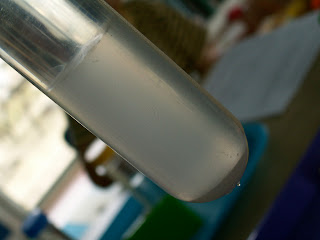
Lesson 5: Separation of a mixture
Chromatography
First we reviewed the definition of a mixture and the ways to separate them. Then I mixed 3 colors of water and we discussed how it was a mixture of pigment and water and how we could separate each of the colors back out again.
I gave them a brief description of chromatography and what it meant. Then using 4 different black pens they drew on coffee filters. Then we set dampened cotton balls on the filters and allowed the water to slowly absorb into the filter paper. The above picture is of one of the black inks which separated out into yellow, red and blue....
They started to test all the markers then....they hypothesized that the blue wouldn't separate at all since it was a primary color, but were surprised when purple and light blue came out.
Chromatography
First we reviewed the definition of a mixture and the ways to separate them. Then I mixed 3 colors of water and we discussed how it was a mixture of pigment and water and how we could separate each of the colors back out again.
I gave them a brief description of chromatography and what it meant. Then using 4 different black pens they drew on coffee filters. Then we set dampened cotton balls on the filters and allowed the water to slowly absorb into the filter paper. The above picture is of one of the black inks which separated out into yellow, red and blue....
They started to test all the markers then....they hypothesized that the blue wouldn't separate at all since it was a primary color, but were surprised when purple and light blue came out.

Lesson 6: Solubility
First was vocabulary: solution, solute, solvent and solubility
Then a refresher on the scientific method. This time I wanted them to follow the steps and pay attention to the process....
The Problem:
Which solvent will hold the most solute?
Which solute has the greater solubility?
The Hypothesis:
Cale guessed that the water would dissolve more, Rylan guess the alcohol
Rylan said sugar would have the greater solubility, Cale guessed Epsom Salts, Cohen guessed table salt.
The Procedure:
First we measured out 35 mL of water in to each of 3 tubes. They chose which solute they would dissolve first and scooped 1/2 tsp of that solute into the water. Capped the tube and shook. They repeated this process until the solute would no longer dissolve. Then they repeated the same process, but this time using alcohol as the solvent.
First was vocabulary: solution, solute, solvent and solubility
Then a refresher on the scientific method. This time I wanted them to follow the steps and pay attention to the process....
The Problem:
Which solvent will hold the most solute?
Which solute has the greater solubility?
The Hypothesis:
Cale guessed that the water would dissolve more, Rylan guess the alcohol
Rylan said sugar would have the greater solubility, Cale guessed Epsom Salts, Cohen guessed table salt.
The Procedure:
First we measured out 35 mL of water in to each of 3 tubes. They chose which solute they would dissolve first and scooped 1/2 tsp of that solute into the water. Capped the tube and shook. They repeated this process until the solute would no longer dissolve. Then they repeated the same process, but this time using alcohol as the solvent.

The Results:
| | Water | Alcohol |
| Salt | | |
| Sugar | | |
| Epsom salt | | |

Conclusions:
Water can hold more solutes, and we discussed a little about water being the universal solvent. Sugar had a greater solubility in both solvents.

It was nice to see them bringing in information from the past lessons...Rylan was talking about molecule size and noticing that the volume of his tube (with 18 scoops of sugar) was about to overflow, but Cale's (with 18 scoops of Epsom salts) still had about 1.5 inches to the top of the tube. Cale had a hard time with that- since the visual size of the E. salts are much bigger than the sugar crystals.

Your science experiments are so great and interesting even I am learning alot as I read your blog.
ReplyDeleteI know we will try a few just not sure when and which ones yet. Thanks again very much for sharing your information and what you guys discover. I love those test tube experiments.
Sheila
Sadie,
ReplyDeleteWhat a fantastic chemistry lesson set! I'm again really struck by how consistent your lessons are. Did you come up with the units on your own (like your art units)? Fantastic!